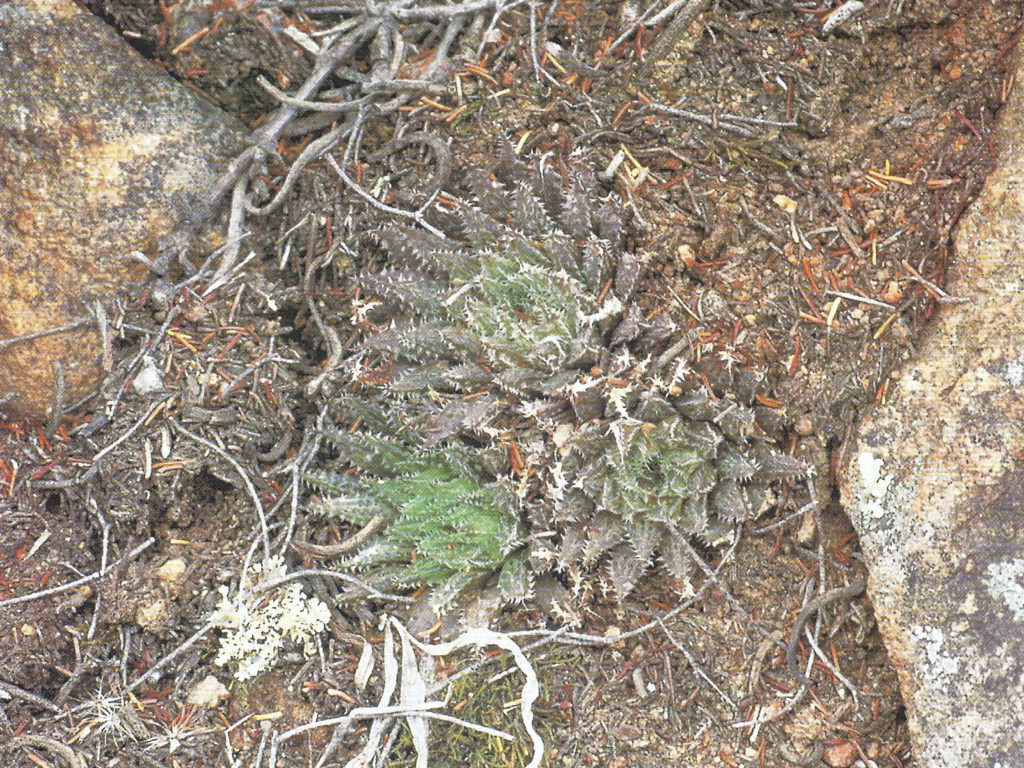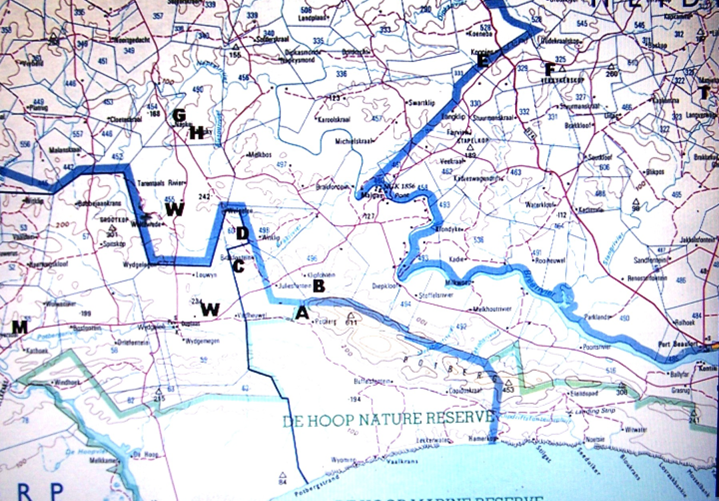19. Haworthia maraisii V.Poelln., Feddes Repert.Spec.Nov. 38:194(1935). idem. 43:104(1938). Bayer :141(1976). H. magnifica var. maraisii (V.Poelln.) Bayer, Natn.Cact.Succ.J 32:18(1977). Bayer :44,106(1982). Type: Cape, Swellendam, Marais in Swellendam 6410. Lectotype (Bayer, 1976): Icon (B): H. schuldtiana V.Poelln., Feddes Repert.Spec.Nov. 41:211(1937). idem. 43:102(1938). idem. 49:23(1940). Type: Cape, Robertson, SW. McGregor G.J. Payne in Triebn. 903. Lectotype (Bayer, 1976): icon (B): H. schuldtiana var. robertsonensis idem. 49:25(1940). V.Poelln., Des.Pl.Life 9:101(1937). Type: Cape, Robertson, G.J. Payne in Triebn. 991. Not preserved: H. schuldtiana var. minor Triebn. et V.Poelln., Feddes Repert.Spec.Nov. 49:25(1940). Type: Cape, McGregor, G.J. Payne in Triebn. 1096. Not preserved: H. schuldtiana var. subtuberculata V.Poelln. ibid. 49:26(1940). Type: Cape, N. McGregor, G.J. Payne in Triebn. 1089. Not preserved: H. whitesloaneana V.Poelln., Desert.Pl.Life 9:102(1937). idem Feddes Repert.Spec.Nov. 43:107(1938). H. schuldtiana var. whitesloaneana V.Poelln., Feddes Repert.Spec.Nov. 49:26(1940). Type: Cape, McGregor, G.J. Payne in Triebn. 1021. Not preserved. Lectotype (Bayer, 1976): icon (B): H. schuldtiana var. sublaevis idem. 49:26(1940). Type: Cape, loc. unknown, Beukman in Long 690. Not preserved: H. schuldtiana var. simplicior idem. 49:26(1940). Type: Cape, Malgas, G.J. Payne in Triebn. 1112. Not preserved. H. schuldtiana var. unilineata idem. 49:26(1940). Type: Cape, N. McGregor, G.J. Payne in Triebn. 1089. Not preserved. Neotype (designated here): McGregor (-DD), Payne in PRE34897: H. sublimpidula V.Poelln., Cactus J 5:33(1936). idem. Feddes Repert.Spec.Nov. ibid. 41:212(1937). idem. 43:105(1938). idem. Beitr.Zukk.Pfl. 1:45(1939). Type: Cape, Swellendam, Hurling in Triebn. 847. Not preserved. Lectotype (Bayer, 1976): icon.B: H. triebneriana var. diversicolor Triebn. et V.Poelln. ibid. 47:9(1939). Type: Cape, Olifantsdoorn, McGregor, G.J. Payne in Triebn. 1092. Not preserved. Neotype: CAPE-3319 (Worcester): Olifantsdoorn Kloof (-DD), Payne in PRE34881: H. angustifolia var. subfalcata V.Poelln. Sukkulentenkunde 4(1951), nom. inval.
maraisii: for W.R.B. Marais.
Rosette stemless, slowly proliferous, 4-7cm φ. Leaves few to many, very dark green, opaque, usually retused, scabrid with small raised tubercles, tubercles occasionally spined, margins and keel with small spines. Inflorescence slender, to 30cm. Flowers outer upper lobes pinched, frequently yellow throated.
This species was previously treated under H. magnifica and it is now taken out as the smaller darker range of populations from Heidelberg westwards. It is a very common element which is seldom abundant at any one locality. It co-occurs with H. heidelbergensis, H. herbacea, H. reticulata, H. turgida, and H. mutica of the same sub-genus. It is found close to H. mirabilis but it does not co-occur with this species and there are two populations known which appear to be intermediate.
Breuer and Metzing note that a lectotype for H. maraisii was designated by Bayer (1982), when in fact a Berlin-Dahlem illustration was regarded as a type by virtue of the non-preservation of anything else. It is highly unlikely that there was any other preserved material. They nominate presumably the same illustration as a lectotype. Then they state that this illustrations is not original material in the sense of the code, but also that a lectotype must be chosen from the original material.

a. var. maraisii.
The variety is typified by a rather robust form at Stormsvlei whereas it is generally a little smaller elsewhere. Note can be made of forms near Robertson which are rather similar to H. pubescens, forms near Bonnievale in which the leaves are rather guttate (spotted), and to near Eilandia which have short erect leaves. The Bonnievale plants are particularly difficult because of a number of populations which are uncharacteristic and vary from the recognisable H. maraisii var. meiringii to a small form which co-occurs with the typical variety. Even the possibility of interaction with H. heidelbergensis cannot be excluded.
Distribution: 3319 (Worcester): Trappieskraalkloof (-DC), Bayer 1210 (NBG); Langkloof (-DC), Bayer 1215 (NBG), Moffett (NBG); Dublin (-DC), Stayner in KG400/61 (NBG); S. Goudmyn Bridge (-DD), Bayer in KG163/70 (NBG); Goudmyn (-DD), Bayer 1216 (NBG); 18km Robertson to Bonnievale (-DD), Bayer in KG46/70 Langvlei (-DD), Scott 2211 (PRE); 5km E. McGregor (-DD), Payne & Scott 22 (PRE); 1.5km S. Robertson (-DD), Scott 2210 (PRE); Muiskraalkop (-DD), Hurling & Neil (BOL), Bayer 1707 (NBG); McGregor (-DD), Payne in PRE34883, Smith 3977, 5606, 5765, 5774 (NBG), Triebn. 1089 in Smith 5767 (NBG); W. McGregor (-DD), Bayer 4437 (NBG); McGregor (-DD), Payne in PRE34897; Vrolijkheid (-DD), UPE 3207 (PRE); SE. McGregor (-DD), Smith 3975 (NBG); S. McGregor (-DD), Bayer 1222 (NBG); Olifantsdoorn Kloof (-DD), Payne in PRE34881, Smith 5774 (NBG); Houtbaai Kloof (-DD), Payne in PRE 34887, Smith 5766 (NBG); Bayer & Stayner 2271 (NBG); W. Robertson (-DD), Bayer 1211, 1703, in KG628/69 (NBG); Bonnievale to Robertson (-DD), Smith 3980 (NBG); Skurweberg (-DD),Bayer 1221 (NBG); SW. Robertson (-DD), Smith 3987 (NBG), Bayer in KG688/69 (NBG); 9km W. Robertson (-DD), Bayer in KG630/69, in KG345/71 (NBG); Klaasvoogds (-DD), Smith 398, 2836 (NBG), Bayer 1220 (NBG). 3320 (Montagu): Dobbelaarskloof (-CB), Bruyns (NBG); N. Ashton (-CC), Bayer 1708 (NBG); Goedverwacht (-CC), Bayer 2177 (NBG); N. Drew (-CC), Bayer 1219 (NBG); Drew (–CC), De Kok 295 (NBG); Cogmanskloof (-CC), Littlewood in KG520/60 (NBG); 6km N. Drew (-CC), Smith 5615 (NBG); Bonnievale (-CC), Marloth 14186 (PRE); Barrydale (-DC), Smith 7353 (NBG), Bolus (BOL), Hurling & Neil (BOL). 3419 (Caledon): N. Napier (-BD), Venter 3 (NBG). 3420 (Bredasdorp): Stormsvlei (-AA), Smith 2700, 2367, 5158, 5641 (NBG); 32km Swellendam to Caledon (-AA), Smith 3250, 3251 (NBG); 7km N. Stormsvlei (-AA), Bayer 1213 (NBG); Rondeheuwel (-AA), Bayer in KG326/71 (NBG); 19km N. Bredasdorp (-AC), Smith 5476 (NBG), Bayer in KG35/70 (NBG); Juliusfontein (-AD), Bayer 1221 (NBG); SW. Heidelberg (-BB), Bayer in KG104/74 (NBG); Skeiding (-BB), Smith 7219 (NBG); Ziekenhuis (-BC), Bruyns in KG49/76 (NBG); Potberg (-BC), Burgers 2506 (NBG); Infanta (-BD), Malherbe in NBG673/41 (NBG), Smith 5477 (NBG).
Inadequately located: Swellendam, Marais in STE6410 (NBG), Smith 5055 (NBG); Stormsvlei, Payne (NBG); Robertson, Payne (NBG), Malherbe in NBG172/41; Swellendam, Malherbe in NBG299/40; Bredasdorp, Barker in NBG698/33, Venter 18 (BOL); Stormsvlei to Bonnievale, Lewis in NBG2456/32 (BOL); Robertson, Esterhuysen (BOL), Hurling & Neil (BOL), Herre in STE6379 (BOL); Bonnievale, van der Merwe 94 (BOL); Bredasdorp, Venter 20 (BOL), Hurling & Neil (BOL).

Haworthia maraisii var. maraisii JDV95/1 Rooiberg. The end-area is shorter and more deltoid than in H. magnifica. 
Haworthia maraisii var. maraisii JDV95/15 west of Robertson. There is a wide array of differing populations around Robertson. 
Haworthia maraisii var. maraisii JDV85/15 Napier. At this locality the plants are small and the leaves rounder at the tip.

Haworthia maraisii var maraisii JDV86/50 Rooiberg. The plants are invariably well hidden. 
Haworthia maraisii var. maraisii JDV87/1 17 Stormsvlei. The species was originally described from where the plants are quite large for the species.

Haworthia maraisii var. maraisii JDV87/118 Rondeheuwel. A population where the species seems to hybridize with H. mirabilis. 
Haworthia maraisii var. maraisii JDV86/7 Rooivlei. Like the Napier plants, very dark and with more abrupt leaf-tips 
Haworthia maraisii var. maraisii JDV94/18 southeast of Worcester. The first collection from here was by Roy Littlewood. The plants were very dark with erect pointed leaves, but that population appears to have vanished.
b. var. meiringii Bayer
:134(1976). H. magnifica var. meiringii Bayer, Natn.Cact.Succ.J 32:18(1977). Bayer :45(1982). Type: CAPE‑3320 (Montagu): E. of Bonnievale (‑DC), Bayer in KG 224/70 (NBG).
meiringii: for P.L. Meiring.
1982 – The var. meiringii appears vegetatively very like a smaller, darker green version of H. herbacea, until it flowers. Also to the west it intergrades into the more characteristic retuse‑leaved var. maraisii.
1999 – This variety has the growth form of H. herbacea but is a smaller darker green species with the same flowers and flowering time as H. maraisii. It occurs east of Bonnievale, and westwards transposes to a more rigid-leaved form with erect thin scabrid leaves which practically co-occurs with the typical form of that species. Immediately west of Bonnievale it appears to intermingle with H. heidelbergensis in dense populations.
Distribution: 3319 (Worcester): W. Bonnievale (-DD), Smith 3822 (NBG). 3320 (Montagu): Bonnievale (-CC), Marloth 11855 (PRE); E. Bonnievale (‑CC), Smith 3948 (NBG), Bayer in KG 224/70 (NBG); W. Bonnievale (-CC), Bayer 1214, 1217 (NBG), Bayer in KG2/71 (NBG), Bayer 1218, in KG7/71, in KG9/71 (NBG).
Inadequately located: Bonnievale, Malherbe in Smith 3428 (NBG), Smith 5060 (NBG), van der Merwe 95 (BOL); ex hort, Hurling & Neil (BOL); Drew, Hurling & Neil (BOL).

Haworthia maraisii var meiringii JDV96/15 west of Bonnievale. The density of this population is surprising. 
Haworthia maraisii var meiringii JDV90/94 east of Bonnievale. The shape and colouration of the plants is very reminiscent of H. herbacea. 
Haworthia maraisii var meiringii JDV87/121 west of Bonnievale. Becomes very variable proceeding westward, and at this locality the plants are very spotted.
c. var. notabilis (V.Poelln.) Bayer
:141(1976). H. notabilis V.Poelln., Feddes Repert.Spec.Nov. 44:134(1938): H. magnifica var. notabilis Bayer, Natn.Cact.Succ.J 32:18(1977). Bayer :45(1982). Scott :146(1985). Type: Cape, Wolfkloof, G.J. Payne in Triebn. 1103. Not preserved. Lectotype (B&M): icon (B): H. schuldtiana var. erecta Triebn. et V.Poelln. ibid. 49:25(1940). Type: Cape, Bonnievale, Stellenbosch. Not preserved: H. nitidula var. opaca V.Poelln., Desert.Pl.Life 20:4(1948). Type: Cape, Klaasvoogds. Not preserved:
notabilis: noteworthy.
1982 – The variety notabilis (then of H. magnifica) also has erect leaves which are darker green and more turgid than in the case of H. herbacea.
1999 – There is difficulty in comparing this variety with H. maraisii. The decision to place it here was taken on account of the variation at the type locality, the similarity of the flowers and flowering times, and also because of the forms originally seen at Klaasvoogds, which were darker and more compact than the more turgid of the Wolfkloof forms. At Wolfkloof, a turgid, lighter green form grows on the east of the valley where it is on shales. On the west side is a granite formation and the forms are very toothed and have longer more slender leaves. There also appears to be a third form a little to the southwest which has the firmer textured leaves of H. reticulata which co-occurs there. More than one population is now known at Klaasvoogds and the plants appear to vary substantially. There is yet another population at Agtervink which is comparable to the Klaasvoogds and eastern Wolfkloof plants. Finally there is H. maculata var. intermedia at Buitenstekloof which has a different flowering time. It is these odd indistinctly related populations which appear to be influenced by ecotypic (largely geological) factors. All the populations discussed here are on rocky sites associated with the great Worcester fault line and the granite and dolomite formations which are exposed there.
The original decision to include this element with var. maraisii was based on quite an extensive study of the flowers and flowering times of a wide range of populations in the Worcester/Robertson Karoo. Variation within those populations which are more obviously of the var. maraisii, seemed to exceed that between them and var. notabilis. Flowering time was also originally thought to have been a very strong character but it seems to break down here as it may in H. magnifica.
Distribution: 3319 (Worcester): Wolfkloof, Robertson (‑DD), Smith 3984 (NBG, PRE), Scott 2204 (PRE), Bayer 1208, 1209 (NBG), Fourcade 166 (NBG), Fourcade 192 (NBG), Hurling & Neil in NBG 2115/37 (NBG); Robertson (-DD), Payne in PRE39466; Vinkrivier (-DD), Bayer 121 (NBG); Klaasvoogds (-DD), Stayner & Bayer in KG 638/69 (NBG).

Haworthia maraisii var. notabilis JDV87/197 northwest of Robertson. This variety occurs as three different ecotypes in close proximity. 
Haworthia marasii var. notabilis JDV87/197 Woolfkloof northwest of Robertson. The granite form is darker coloured and more spinescent.

